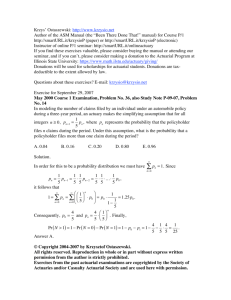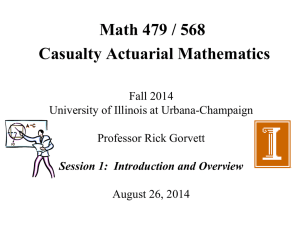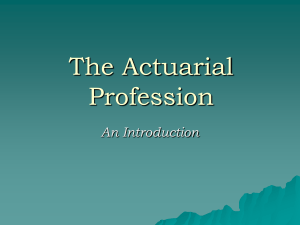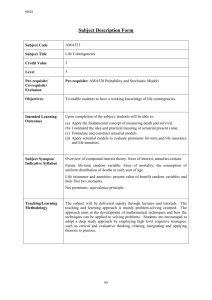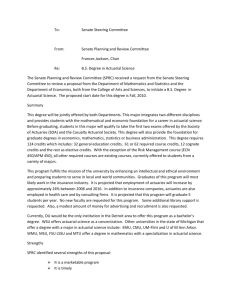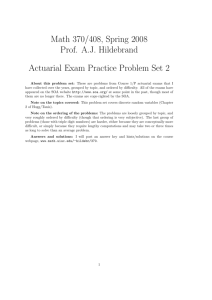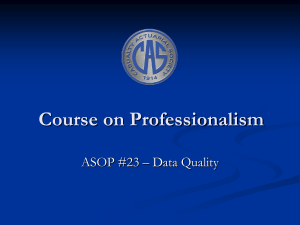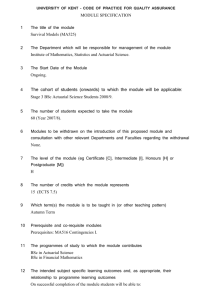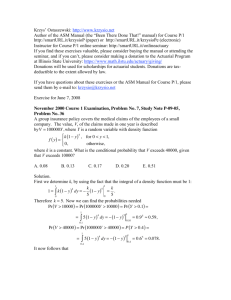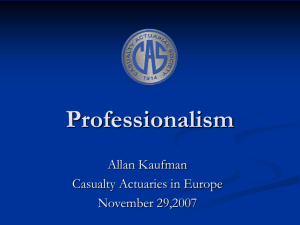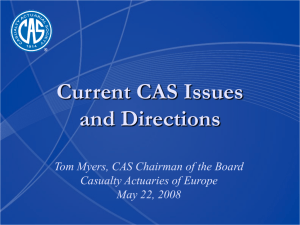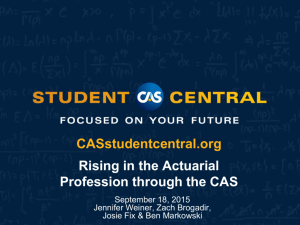The Actuarial Profession - Department of Statistics
advertisement
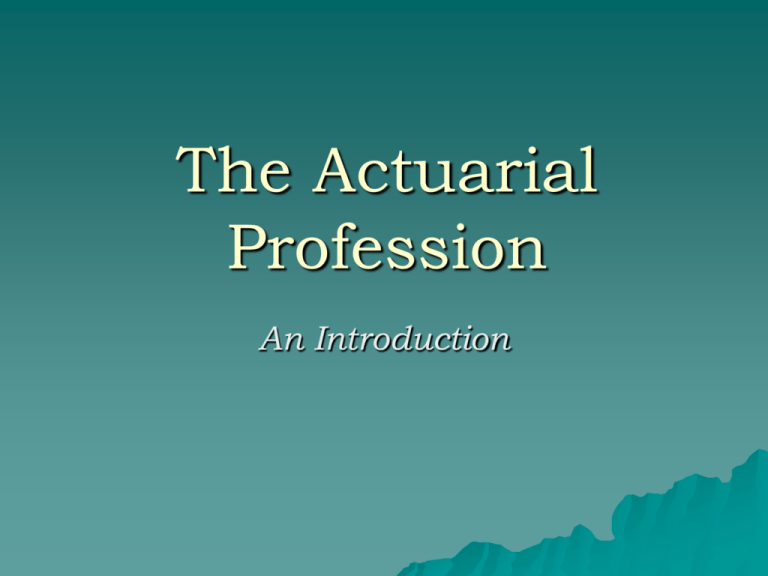
The Actuarial Profession An Introduction What is an Actuary? Is an Actuary a fortune teller? Is an Actuary a professional gambler? Doctrine of False Cause A false cause fallacy is a misidentification of the cause for an observed effect. “Why do…” People who have root canals get cancer more often. People who attend the symphony live longer. People who floss their teeth live longer. Two Branches of Actuarial Science Life & Health / Pension - Society of Actuaries : SOA - around 17,000 in United States Property and Casualty (or Property / Liability) - Casualty Actuarial Society : CAS - 3,425 in United States / 3,857 total P&C Lines of Business Examples Homeowners Earthquake Automobile Mortgage General Liability Medical Malpractice Workers’ Compensation Products Liability Reinsurance Example Actuarial Problems - Pricing New Products - Price Classification - Modeling Catastrophes - Strategic Planning - Graphing Size of Loss Distributions - Establishing Loss Reserves - Solvency Monitoring - Rate Adequacy Studies - Trending and Development of Losses - Current Leveling of Premiums - Credibility Measures Pricing New Products Body Piercing Salon Insurance How would you price that? Loss Development Loss Development 12 months 24 months 36 months 48 months 60 months 1999 8,802,882 9,620,159 9,390,546 9,539,089 9,574,213 2000 9,948,091 11,042,381 10,490,262 10,595,165 2001 11,751,813 12,767,774 12,257,063 2002 13,046,926 14,351,619 2003 14,612,557 12 - 24 24-36 36-48 48-60 1999 1.09 0.98 1.02 1.00 2000 1.11 0.95 1.01 2001 1.09 0.96 2002 1.10 Average 12 - 24 24-36 36-48 48-60 1.10 0.96 1.01 1.00 Loss Development Average 12 - 24 24-36 36-48 48-60 1.10 0.96 1.01 1.00 "Squaring the Triangle" 12 months 24 months 36 months 48 months 60 months 1999 8,802,882 9,620,159 9,390,546 9,539,089 9,574,213 2000 9,948,091 11,042,381 10,490,262 10,595,165 10,634,177 2001 11,751,813 12,767,774 12,257,063 12,415,292 12,461,006 2002 13,046,926 14,351,619 13,806,889 13,985,125 14,036,619 2003 14,612,557 16,034,700 15,426,088 15,625,226 15,682,760 Loss Development 12 months 24 months 36 months 48 months 60 months 1999 8,802,882 9,620,159 9,390,546 9,539,089 9,574,213 2000 9,948,091 11,042,381 11,097,593 11,652,473 2001 11,751,813 13,162,031 13,556,891 2002 13,046,926 14,873,496 2003 14,612,557 12 - 24 24-36 36-48 48-60 1999 1.09 0.98 1.02 1.00 2000 1.11 1.01 1.05 2001 1.12 1.03 2002 1.14 Average 12 - 24 24-36 36-48 48-60 1.12 1.00 1.03 1.00 Graphing Size of Loss Distributions 97 5K 92 5K 87 5K 82 5K 77 5K 72 5K 67 5K 62 5K 57 5K 52 5K 47 5K 42 5K 37 5K 32 5K 27 5K 22 5K 17 5K 12 5K 75 K 25 K Claim Counts by Size 1800 1600 1400 1200 1000 800 600 400 200 0 25 K 50 K 75 10 K 0 12 K 5 15 K 0 17 K 5 20 K 0 22 K 5 25 K 0 27 K 5 30 K 0 32 K 5 35 K 0 37 K 5 40 K 0 42 K 5 45 K 0 47 K 5 50 K 0K 52 5 55 K 0 57 K 5 60 K 0 62 K 5 65 K 0 67 K 5 70 K 0 72 K 5 75 K 0 77 K 5 80 K 0 82 K 5 85 K 0 87 K 5 90 K 0 92 K 5 95 K 0 97 K 5K 1M Lognormal Fit 1800 1600 1400 1200 1000 800 600 400 200 0 Actual Fitted Modeling Catastrophes 1992 Hurricane Load - Florida 1992 Florida Homeowners Premium = $1,000,000,000 ($1 billion) 1992 Florida Homeowners Expected Loss Ratio = 65% => Expected Loss Costs = 65% x $1,000,000,000 = $650,000,000 ($650 million) Excess Wind Factor = 1.14 Expected Loss Costs = Normal Losses x Excess Wind Factor => Normal Losses = $650,000,000/1.14 = $570,000,000 Catastrophe Losses = Total Losses – Normal Losses = $650,000,000 - $570,000,000 = $80,000,000 1992: Hurricane Andrew Photograph © Allan Tannenbaum Today Simulation models are used to estimate hurricane risk, using meteorological data. The Costliest Hurricanes Adjusted to 2004 Cost, Population, and Wealth Levels KATRINA Southeastern Florida/Alabama ANDREW [SE FL / LA ] Northern Texas: Galveston Northern Texas: Galveston Southwestern Florida New England SE Florida: Lake Okeechobee BETSY [SE FL / LA] DONNA [FL / Eastern U.S.] CAMILLE [MS / LA / VA ] AGNES [NW FL / NE U.S.] CHARLEY [SW FL] DIANE [NE U.S.] IVAN [NW FL / AL] HUGO [SC] 2005 1926 1992 1900 1915 1944 1938 1928 1965 1960 1969 1972 2004 1955 2004 1989 > $125 B $102B $43B $37B $31B $23B $24B $19B $18B $17B $15B $15B $15B $14B $14B $13B Solvency Monitoring 1906: San Francisco Earthquake Only one regional insurance company survived, offering company stock in place of cash to settle claims. Today Earthquake risk is estimated with the help of seismologists. Losses are reinsured, spreading the risk globally. Are all losses predictable? View from Liberty International Underwriters October 2001 Photograph by Ivan Rodriguez 2004 Prediction National Oceanic and Atmospheric Administration “In virtually every coastal city from Texas to Maine, the present Tropical Prediction Center Director (Max Mayfield) former National Hurricane Center Directors have stated that the United States is building towards its next hurricane disaster. … The areas along the United States Gulf and Atlantic coasts where most of this country’s hurricane related fatalities have occurred are also now experiencing the country’s most significant growth in population. This situation, in combination with continued building along the coast, will lead to serious problems for many areas in hurricanes.” Insurer Insolvencies Number of Insurer Insolvencies 60 50 40 30 20 Year A few insurers go insolvent every year for different reasons. Catastrophes are no longer the leading cause of insolvencies. 2002 2001 2000 1999 1998 1997 1996 1995 1994 1993 1992 1991 1990 1989 1988 1987 1986 1985 1984 1983 1982 1981 1980 1979 1978 1977 1976 1975 1974 0 1973 10 1972 Number of Insolvencies 70 Who do actuaries work for? Insurance companies Consulting firms Government insurance departments Colleges and universities Banks and investment firms Large corporations Public accounting firms Failure Analysis firms Reinsurers Themselves Who do actuaries work with? Other Actuaries (e.g. mentors, peers, students) Underwriting (e.g. pricing large accounts) Sales (e.g. developing pricing strategies) Marketing (e.g. retention analyses) Claims (e.g. loss reserving studies) Risk Management (e.g. response to loss trends) Clients / Large Insureds Reinsurers Advantages to the Actuarial Profession High earnings potential No cost of graduate school – no loans to repay Option to begin retirement savings early to compound it Advance by examinations – no “glass ceiling” Advancement opportunities expand throughout career Professional Interactions – “Front Office” role Variety of avenues to choose Newsworthy projects High demand – less sensitive to economic cycles Job security Financial Savvy – gain personal investing skills Overall, a highly ranked profession The Jobs Rated Almanac ranks careers according to: Environment Income Outlook Physical Demands Security Stress Jobs Rated Almanac Top 10 2001 - #1 Financial Planner - #2 Website Manager - #3 Computer Systems Analyst #4 ACTUARY #5 Computer Programmer #6 Software Engineer #7 Meteorologist #8 Biologist #9 Astronomer #10 Paralegal Assistant Jobs Rated Almanac Top 10 2002 - #1 Biologist #2 ACTUARY #3 Financial Planner #4 Computer Systems Analyst #5 Accountant #6 Software Engineer #7 Meteorologist #8 Paralegal Assistant #9 Statistician #10 Astronomer Average Earnings based on level of formal education High School: Bachelor’s: Master’s: Ph.D: $12,900 $49,700 $61,000 $80,000 Average Earnings comparison to the actuarial profession All professions P&C Actuaries only starting salary BA: $49,700 MA: $61,000 Ph.D: $80,000 1 exam: ACAS: FCAS: $41 - $53K $77,000 $145,000 Without considering… average debt from student loans The Cost of Graduate School MBA: $20,000 / year (tuition only) M.A.: $35,000 / year (all costs) [ Example: Syracuse Architectural program ] Ph.D.: Graduate students may receive a stipend for research or teaching Without considering … delayed saving for retirement Retirement Planning from age 22 Every $100/month saved for seven years (length of Ph.D. program) at 10% interest, by age 65 will amount to $370,714. Saving 4% of income (increasing from $38,000/year to $77,000/year), with 2% employer matching for 7 years at 10% by age 65 will total over $1 million. (Caveat: in today’s dollars, $1,000,000 = $325,775*) *Assuming a 3% annual rate of inflation Disadvantages to the Actuarial Profession Difficulty of the examination process Frustrating data problems Narrow field with high degree of specialization Confinement to an office (non-consultant) Required travel and long hours (consultant) Relocation may be necessary for ACAS or FCAS May not provide good topics of conversation Where do Most P&C Actuaries Live? Illinois 414 Wisconsin 112 Connecticut 397 Minnesota 109 New York 366 D.C. (MD & VA) 107 New Jersey 317 Texas 102 California 266 Florida 97 Pennsylvania 233 Georgia 94 Massachusetts 166 Washington 64 Ohio 130 North Carolina 46 What are some other choices for P&C Actuaries to live? Michigan 44 Arizona 21 Iowa 42 Indiana 19 Missouri 41 Colorado 18 Kansas 40 Oregon 12 Rhode Island 35 Delaware 10 New Hampshire 31 South Carolina 9 Tennessee 22 Nebraska 8 Where might a P&C actuary be hard pressed to find a job? Alabama 7 Idaho 2 Louisiana 6 Montana 2 Maine 6 Oklahoma 2 Nevada 6 West Virginia 2 Kentucky 4 Arkansas 1 Vermont 4 Hawaii 1 Mississippi 3 North Dakota 1 New Mexico 3 Utah 1 Alaska 2 Wyoming 0 International CAS Members Canada 246 China 3 Bermuda 73 Mexico 3 United Kingdom 31 South Korea 3 Switzerland 22 Brazil 2 Singapore 7 Israel 2 Taiwan 7 Barbados (W.I.) 1 Australia 6 Cayman Islands 1 France 6 Italy 1 Germany 6 Japan 1 Hong Kong 6 South Africa 1 Ireland 4 Two Branches of Actuarial Science REVISITED CAS: Casualty Actuarial Society (Property & Casualty) 3,425 in United States / 3,857 total SOA: Society of Actuaries (Life & Health / Pension) around 17,000 in United States How do I choose a path? In the CAS and SOA, Exam Parts 1, 2, & 4 are the same. CAS Exam 1 = SOA Exam P CAS Exam 2 = SOA Exam FM CAS Exam 4 = SOA Exam C CAS Actuarial Examinations Associate Level Exams Exam 1 2 3 4 5 6 7 Topic Probability Financial Mathematics Statistics and Actuarial Models Construction and Evaluation of Actuarial Models Introduction to P&C Insurance and Ratemaking Reserving, Insurance Accounting Principles, and Reinsurance Annual Statement, Taxation, Regulation (U.S. or Canada) CAS Actuarial Examinations Fellowship Level Exams Exam Topic 8 9 Investments and Financial Analysis Advanced Ratemaking, Rate of Return, and Individual Risk Rating Plans CAS and SOA Actuarial Examinations Exam 1 “Probability” A. General Probability B. Univariate Probability Distributions: binomial, negative binomial, geometric, uniform, hypergeometric, Poisson, exponential, Pareto, normal, chi-square, beta, lognormal, gamma, and Weibull C. Multivariate Probability Distributions CAS and SOA Actuarial Examinations Exam 2 “Financial Mathematics” A. Interest Theory B. Finance Validation by Educational Experience (“VEE”) 1. Applied Statistical Methods 2. Corporate Finance 3. Economics Skills and Personality Traits to succeed as an Actuary • • • • • • • • • • • Analytic thinking Problem solving Good common sense / “business” sense Facility with Mathematics Ability to explain complex ideas Organized, concise writer Determination Independence Disciplined study habits Tendency to start projects early Comfortable using computer programs like Excel, Access, Word, SAS The Changing Face of Actuaries In 2003, women held the presidency in three of the five professional organizations governing the field of actuarial science. Pictured are: - Barbara Lautzenheiser, president of the American Academy of Actuaries (FSA 1969); - Mary Frances Miller, president of the Casualty Actuarial Society (FCAS 1988); and - Margaret Tiller Sherwood, president of the Conference of Consulting Actuaries (FCAS 1982, ASA 1984). The International Association of Black Actuaries IABA’s 2002 Annual Meeting Membership in IABA is growing. Advancing Diversity Minority Students: – African American, Latino, or Native American Scholarships for Minority Students – Individual awards of $500 - $3,000, annually – Demonstrated performance and commitment Exam Fee Reimbursement for Minority Students – Reimbursed for successfully passing Exam 1 – $175 exam fee reimbursed, up to two times ($350) Visit the website www.BeAnActuary.org Minority Programs: Scholarship applications, exam fee reimbursement forms, internships, and more. Write this down! The CAS Website: www.casact.org 1. DETAIL OF EXAMS: Admissions 2006 Syllabus of Basic Education CAS Basic Education Summary 2. ABOUT THE PROFESSION: www.BeAnActuary.org 3. INTERNSHIPS: www.BeAnActuary.org/find/atp.cfm 4. VALIDATION BY EDUCATIONAL EXPERIENCE (VEE): Admissions 2006 Syllabus of Basic Education Validation by Educational Experience 5. CURRENT TOPICS: Continuing Education Meeting and Seminar Handouts View the Chronological List The End
